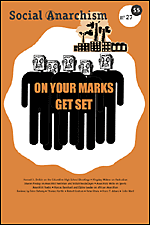DiY Culture
Despite the protestations of some elderly anarchists, the generation gap is as evident among anarchist propagandists as among everyone else. Emma Goldman found this when she first met the elderly Kropotkin, and found that he deprecated her emphasis on the sexual revolution. I can well believe that the people producing new anarchist journals around New York in the second world war (I am thinking of Why?, Resistance, or Politics) became aware of the generation gap when they sought collaboration from survivors from the past, whose preoccupations and priorities, and language too, were different.
A famous biochemist from Argentina explained to me how at the same time he and other students in Buenos Aires started an anarchist group and got in touch with the veterans of suppression and imprisonment who were struggling to keep alive the famous journal La Protesta. César Milstein recollected that "We were the young students coming in, full of energy and wanting to take over the paper and change it. And they were the people obliged to say, 'That's all very nice, but after a few years you will disappear and we will have to keep the paper going.' And they were essentially right."
Two decades later, in the 1960s, on both sides of the Atlantic, another generation of young activists discovered anarchism but usually found few in the older generation to whose language they could relate. Paul Goodman used to talk about his "crazy young allies." And the young tended to invent a new style of anarchism of their own. This was chronicled by George McKay in his 1996 book Senseless Acts of Beauty: Cultures of Resistance since the Sixties, and, conscious a few more decades have rolled past, he now edits an updating volume about the current generation of protest in Britain. He is a Glasgow-born lecturer in the Department of Cultural Studies at the University of Central Lancashire in Preston. Simply to mention this and the background of other contributors is to draw attention to one of the gulfs between the old anarchists and the new. For the old, industrial cities call to mind the revolt of labor against capital, not new academic subjects in new flowerings of higher education.
Much of the history of anarchism, whether we like it or not, is the history of anarchist publications, from Le Révolté and Mother Earth to the journal you are reading now. One chapter in this book is about a magazine, and is by one of its founders, Jim Carey. This was Squall, started in 1992 and initially covering squatting, and the British government's response to it, the situation of gypsies and travelling people, as well as the culture of "raves" and the DiY dance culture. He believes that "as a result, much of the dour laboriousness associated with politics dissolves in a potent concoction of imagination, celebration and dissent." The anti-climax is that since this book went to press Squall has temporarily ceased publication for lack of money to pay the printer, but the good news is that the journal continues on a website, (www.squall.co.uk).
Several contributors describe the dance scene which, one of its historians suggests, "will continue to flourish not because of the strength of any 'movement' or the truth of an ideology, but simply because of the power of its combination of autonomous art and collective intoxication." Others are closer to the realm of traditional anarchism. George Mombiot, a well-known radical journalist in Britain, describes the campaign called The Land is Ours which staged a series of land seizures, both urban and rural, while other contributors stress the significance of the squatters' movement, both for its effect as an ideological demonstration against landlordism and as an immediate practical solution to personal problems.
Another peculiarly British campaign has been the obstruction of new road-building contracts, which has been chosen by young environmental campaigners as a battle — ground with authority. The witty and resourceful protesters, living in tunnels or in tree — houses have begun the process of changing the national mind, for when radical protesters become media heroes, the climate is beginning to change. The campaign is well — described in this book.
I doubt if many anarchists of earlier generations were brought into their particular struggle by controversy over roads, but there aren't many militant activists around in more traditional fields of anarchist propaganda. On the other hand I become more and more aware that the people we have to convince of the validity of an anarchist approach, are not the campaigning heroes and heroines of environmental demonstrations, but our fellow citizens, both among the sizeable poverty-blighted minority, and among the apparently affluent and contented majority too.

